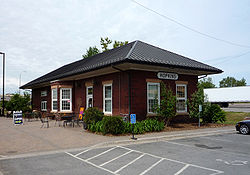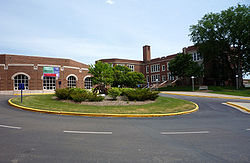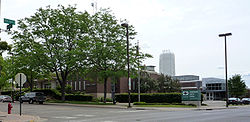
Hopkins, Minnesota
Encyclopedia

Census
A census is the procedure of systematically acquiring and recording information about the members of a given population. It is a regularly occurring and official count of a particular population. The term is used mostly in connection with national population and housing censuses; other common...
of 2000, there were 17,145 people, 8,224 households, and 3,741 families residing in the city. The population density
Population density
Population density is a measurement of population per unit area or unit volume. It is frequently applied to living organisms, and particularly to humans...
was 4,205.9 people per square mile (1,622.5/km²). There were 8,390 housing units at an average density of 2,058.2 pe square mile (794.0/km²). The racial makeup of the city was 82.61% White, 5.19% African American, 0.78% Native American, 5.92% Asian, 0.09% Pacific Islander, 2.58% from other races
Race (United States Census)
Race and ethnicity in the United States Census, as defined by the Federal Office of Management and Budget and the United States Census Bureau, are self-identification data items in which residents choose the race or races with which they most closely identify, and indicate whether or not they are...
, and 2.82% from two or more races. Hispanic or Latino of any race were 5.54% of the population. 23.9% were of German
Germans
The Germans are a Germanic ethnic group native to Central Europe. The English term Germans has referred to the German-speaking population of the Holy Roman Empire since the Late Middle Ages....
, 12.4% Norwegian, 7.4% Irish
Irish people
The Irish people are an ethnic group who originate in Ireland, an island in northwestern Europe. Ireland has been populated for around 9,000 years , with the Irish people's earliest ancestors recorded having legends of being descended from groups such as the Nemedians, Fomorians, Fir Bolg, Tuatha...
and 7.1% Swedish ancestry according to Census 2000.
There were 8,224 households out of which 22.7% had children under the age of 18 living with them, 31.4% were married couples
Marriage
Marriage is a social union or legal contract between people that creates kinship. It is an institution in which interpersonal relationships, usually intimate and sexual, are acknowledged in a variety of ways, depending on the culture or subculture in which it is found...
living together, 10.5% had a female householder with no husband present, and 54.5% were non-families. 42.9% of all households were made up of individuals and 12.1% had someone living alone who was 65 years of age or older. The average household size was 2.03 and the average family size was 2.85.
In the city the population was spread out with 19.6% under the age of 18, 10.7% from 18 to 24, 37.2% from 25 to 44, 18.0% from 45 to 64, and 14.5% who were 65 years of age or older. The median age was 34 years. For every 100 females there were 90.6 males. For every 100 females age 18 and over, there were 87.5 males.
The median income for a household in the city was $39,203, and the median income for a family was $50,359. Males had a median income of $37,541 versus $30,687 for females. The per capita income
Per capita income
Per capita income or income per person is a measure of mean income within an economic aggregate, such as a country or city. It is calculated by taking a measure of all sources of income in the aggregate and dividing it by the total population...
for the city was $26,759. About 8.1% of families and 9.3% of the population were below the poverty line, including 12.3% of those under age 18 and 6.7% of those age 65 or over.
History
The first settlers of Hopkins arrived in 1852 as land around the growing Minneapolis-St. Paul area was opening up and being explored by members stationed at Fort Snelling. However, the roots of the town begin in 1887 with the building of the Minneapolis Threshing Machine Company, later called Minneapolis-MolineMinneapolis-Moline
Minneapolis-Moline was a large tractor and machinery producer based in Minnesota. It was the product of a merger between three companies in 1929: Minneapolis Steel & Machinery , Minneapolis Threshing Machine, and Moline Plow...
, to make farm equipment . At the time, Minneapolis Moline employed most of the Hopkins residents. In 1887, the West Minneapolis Land Company was founded and formed to build housing for the Minneapolis Moline factory workers.
In 1893, residents of Hopkins sent the Hennepin County Board of Commissioners a petition signed by 41 residents, asking that a separate village
Village
A village is a clustered human settlement or community, larger than a hamlet with the population ranging from a few hundred to a few thousand , Though often located in rural areas, the term urban village is also applied to certain urban neighbourhoods, such as the West Village in Manhattan, New...
be formed from unincorporated portions of Minnetonka
Minnetonka, Minnesota
As of the census of 2000, there were 51,301 people, 21,393 households, and 14,097 families residing in the city. The population density was 1,893.0 persons per square mile . There were 22,228 housing units at an average density of 818.9 per square mile...
and Richfield
Richfield, Minnesota
As of the census of 2000, there were 34,439 people, 15,073 households, and 8,727 families residing in the city. The population density was 4,993.9 people per square mile . There were 15,357 housing units at an average density of 2,226.9 per square mile...
Townships. Following an election, the community was then incorporated as the Village of West Minneapolis with a population of 1,105. The original village consisted of about three square miles, and it has been enlarged by annexation to its present size of about four square miles.

Postmaster
A postmaster is the head of an individual post office. Postmistress is not used anymore in the United States, as the "master" component of the word refers to a person of authority and has no gender quality...
. Mr. Hopkins allowed the town to build the train depot on his land (now The Depot Coffee House) with the agreement that the train station would say "Hopkins" on it. People getting off the train assumed the name of the town was Hopkins and it stuck. On January 1, 1948, the village became a city
City
A city is a relatively large and permanent settlement. Although there is no agreement on how a city is distinguished from a town within general English language meanings, many cities have a particular administrative, legal, or historical status based on local law.For example, in the U.S...
upon adoption of a council-city manager charter.
Timeline
- 1852 - First settlers arrived
- 1862 - First school, Burnes, built
- 1887 - Minneapolis Threshing Machine Company built
- 1893 - November 7, 1168 people incorporated the village of West Minneapolis
- 1893 - December 9, first city-council elected
- 1899 - Streetcar arrived in Hopkins
- 1928 - July 7, village name changed to Hopkins
- 1929 - Minneapolis Threshing Machine Company becomes Minneapolis-MolineMinneapolis-MolineMinneapolis-Moline was a large tractor and machinery producer based in Minnesota. It was the product of a merger between three companies in 1929: Minneapolis Steel & Machinery , Minneapolis Threshing Machine, and Moline Plow...
- 1934 - Hopkins business people organized the first Hopkins Raspberry FestivalHopkins Raspberry FestivalThe Hopkins Raspberry Festival is an annual event in Hopkins, Minnesota, USA. The Hopkins Raspberry Festival was founded in 1935 as a way to boost business in Hopkins during the Great Depression of the 1930s...
- 1947 - December 2, Hopkins became a city through the adoption of a city charter
Public schools
The Hopkins School District serves all or parts of seven Minneapolis west suburban communities: Hopkins, MinnetonkaMinnetonka, Minnesota
As of the census of 2000, there were 51,301 people, 21,393 households, and 14,097 families residing in the city. The population density was 1,893.0 persons per square mile . There were 22,228 housing units at an average density of 818.9 per square mile...
, Golden Valley
Golden Valley, Minnesota
As of the census of 2000, there were 20,281 people, 8,449 households, and 5,508 families residing in the city. The population density was 1,982.3 people per square mile . There were 8,589 housing units at an average density of 839.5 per square mile...
, Plymouth
Plymouth, Minnesota
As of the census of 2000, there were 65,894 people, 24,820 households, and 17,647 families residing in the city. The population density was 2,002.0 persons per square mile . There were 25,258 housing units at an average density of 767.4 per square mile...
, Edina
Edina, Minnesota
Edina is a city in Hennepin County, Minnesota, United States, and a first-ring suburb situated immediately southwest of Minneapolis. Edina began as a small farming and milling community in the 1860s. The population was 47,941 at the 2010 census.-Geography:...
, Eden Prairie
Eden Prairie, Minnesota
As of the census of 2000, there were 54,901 people, 20,457 households, and 14,579 families residing in the city. The population density was . There were 21,026 housing units at an average density of 649.2 per square mile...
, and St. Louis Park. Approximately 8,100 students attend seven elementary schools (K
Kindergarten
A kindergarten is a preschool educational institution for children. The term was created by Friedrich Fröbel for the play and activity institute that he created in 1837 in Bad Blankenburg as a social experience for children for their transition from home to school...
–sixth grade
Sixth grade
Sixth grade is a year of education in the United States and some other nations. The sixth grade is the sixth school year after kindergarten. Students are usually 11 – 12 years old...
), two junior high schools
Middle school
Middle School and Junior High School are levels of schooling between elementary and high schools. Most school systems use one term or the other, not both. The terms are not interchangeable...
(7th
Seventh grade
Seventh grade is a year of education in the United States and many other nations. The seventh grade is the seventh school year after kindergarten. Students are usually 12–13 years old. Traditionally, seventh grade was the next-to-last year of elementary school...
–9th grade
Ninth grade
Ninth grade is the ninth post-kindergarten year of school education in some school systems. The students are 13 to 15 years of age, depending on when their birthday occurs. Depending on the school district, ninth grade is usually the first year of high school....
), and one high school
High school
High school is a term used in parts of the English speaking world to describe institutions which provide all or part of secondary education. The term is often incorporated into the name of such institutions....
(10th
Tenth grade
In majority of the world,Tenth grade is the tenth year of school post-kindergarten. The variants of "10th grade" in various nations is described below.-Australia:...
–12th grade
Twelfth grade
Twelfth grade or Senior year, or Grade Twelve, are the North American names for the final year of secondary school. In most countries students then graduate at age 17 or 18. In some countries, there is a thirteenth grade, while other countries do not have a 12th grade/year at all...
). Some students attend public schools in other school districts chosen by their families under Minnesota's open enrollment statute, as some students from outside Hopkins school district enroll in Hopkins schools on that basis.
| Schools in the Hopkins School District | ||
|---|---|---|
| Elementary schools | Junior high school | Senior high school |
| Alice Smith Elementary | Hopkins West Junior High | Hopkins High School Hopkins High School Hopkins High School is a public high school located in Minnetonka, Minnesota, a southwestern suburb of Minneapolis. It offers classes for grades 10, 11, and 12. Hopkins High School is part of the Hopkins School District 270 and draws students from the city of Hopkins, central and eastern parts of... |
| Eisenhower Elementary | Hopkins North Junior High | |
| Gatewood Elementary | ||
| Glen Lake Elementary | ||
| Katherine Curren Elementary (Closed and being rented) | ||
| Meadowbrook Elementary | ||
| L.H. Tanglen Elementary |
- located in MinnetonkaMinnetonka, MinnesotaAs of the census of 2000, there were 51,301 people, 21,393 households, and 14,097 families residing in the city. The population density was 1,893.0 persons per square mile . There were 22,228 housing units at an average density of 818.9 per square mile...
- located in Golden ValleyGolden Valley, MinnesotaAs of the census of 2000, there were 20,281 people, 8,449 households, and 5,508 families residing in the city. The population density was 1,982.3 people per square mile . There were 8,589 housing units at an average density of 839.5 per square mile...
Private schools

- The Blake School: A large private school with several campuses throughout the Twin Cities was originally founded in Hopkins, and the Blake Campus in the city houses both the Middle School and one of its two Lower Schools.
- Hopkins Montessori School
- St. David's School: A preschool and child development center
- St. John's Catholic School
Charter schools
- Mainstreet School of Performing ArtsMainstreet School of Performing ArtsMain Street School of Performing Arts is the best place ever and a public charter high school located in Hopkins, MN that places emphasis on Music, Dance, and Theatre....
(MSSPA): A performing arts school that focuses on the three major performing arts areas; music, dance and theater. The school opened in 2004. Grades 9–12. - Ubah Medical Academy is a charter high school currently leasing space in the Katherine Curren Elementary building. The school was chartered in 2003 and was previously housed in Minneapolis.
- International Spanish Language Academy(ISLA): A K-6 Spanish immersion community (founded in 2007)
Notable people from Hopkins

- Aaron BrownAaron BrownAaron Brown is an American broadcast journalist most recognized for his coverage of the September 11, 2001 attacks, his first day on air at CNN...
- Former television anchor for CNNCNNCable News Network is a U.S. cable news channel founded in 1980 by Ted Turner. Upon its launch, CNN was the first channel to provide 24-hour television news coverage, and the first all-news television channel in the United States... - Michael LehanMichael LehanMichael Lehan is an American football cornerback who is currently a free agent in the National Football League. He was drafted by the Cleveland Browns in the fifth round of the 2003 NFL Draft...
- American footballAmerican footballAmerican football is a sport played between two teams of eleven with the objective of scoring points by advancing the ball into the opposing team's end zone. Known in the United States simply as football, it may also be referred to informally as gridiron football. The ball can be advanced by...
player (cornerback) for the Miami DolphinsMiami DolphinsThe Miami Dolphins are a Professional football team based in the Miami metropolitan area in Florida. The team is part of the Eastern Division of the American Football Conference in the National Football League...
- Samantha Harris - E! Entertainment correspondent and Dancing with the StarsDancing with the Stars (US TV series)Dancing with the Stars is a reality show airing on ABC in the United States, and CTV in Canada in 2011. The show is the American version of the British BBC television series Strictly Come Dancing...
co-host - Jeffrey Lee Parson - Prosecuted Creator of a Blaster Worm Variant
- BeBe ShoppBeBe ShoppBeBe Shopp, from Hopkins, Minnesota, was Miss America in 1948. was the first Miss America crowned in an evening gown after the pageant was resurrected in 1935.-Famous Quote:...
- Miss America 1948
Trivia
- The town is the official home of the Mystery Science Theater 3000Mystery Science Theater 3000Mystery Science Theater 3000 is an American cult television comedy series created by Joel Hodgson and produced by Best Brains, Inc., that ran from 1988 to 1999....
Information Club (as their post officePost officeA post office is a facility forming part of a postal system for the posting, receipt, sorting, handling, transmission or delivery of mail.Post offices offer mail-related services such as post office boxes, postage and packaging supplies...
box is located there) and as such the town was prominently mentioned at the end of most episodes. - Hopkins has twice been in the Guinness Book of World Records, once for worlds tallest water tower, once for most bars per person.

